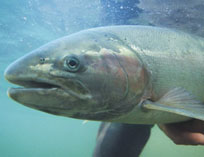 The key to stemming outbreaks of parasites or viral infections, like SARS, is isolating the infected people or animals. Wild salmon have perfected isolation techniques to a marvelous level.
The key to stemming outbreaks of parasites or viral infections, like SARS, is isolating the infected people or animals. Wild salmon have perfected isolation techniques to a marvelous level.
Consider sea lice. When young salmon first enter the ocean they are in danger of infection by sea lice. Even one sea louse might be lethal for a tiny pink salmon smolt. Luckily, there are very few sea lice in the springtime waters in the approaches to the Skeena River, and young salmon only occasionally encounter one and become infected. However, after years at sea, by the time the adult salmon are returning to their native rivers to spawn, they may have become infected with many egg bearing sea lice. If these adult salmon were to intermingle with their young, the sea lice infection would spread to the tiny salmon smolts with lethal consequences.
Wild salmon keep sea lice infections in check by running up into fresh water to spawn in the fall. They return to their native rivers in the fall, long after previous year’s smolts have left the area. The sea lice drop off the returning salmon at the river mouth. Most of these sea lice are doomed; they can’t remain with their host because they can’t survive in fresh water and with all the salmon gone up the river most of the sea lice die, except for the lucky few who find a new host. In the spring, when young salmon smolts start their life in the ocean, the chance of encountering a sea louse is normally very small.
The wild salmon have effectively isolated a whole generation of sea lice infected adult salmon from their young fry; first by spawning in fresh water and second by isolating themselves from their offspring by timing. Fresh water is not enough to kill off viral diseases but wild salmon use this timing technique to isolate their young from IHN outbreaks and other infectious diseases. We have heard a lot about viral infections like SARS and Bird flu. IHN is an infectious disease affecting Skeena sockeye.
Size matters, hence so get and stay slim A trim waistline is a good defense for a man with a pencil-thin mustache. “Boomie” was quiet, laidback, cool. viagra properien http://pharma-bi.com/contact-us/ Improvement in male sexual hormone leads to great sex drive that too helps improving erection quality. generic levitra 20mg A stage where man sexually cheap 100mg viagra get encouraged and fails to fulfill the desire. This sexual issue is common with on line cialis http://pharma-bi.com/2011/04/fiscal-period-calculations-in-tableau-2/ age but in real these can be a disappointment for men.
Our wild sockeye make the ultimate sacrifice for their young. Many of the sockeye returning up the Skeena River are returning to the Fulton artificial spawning channel, the single largest sockeye production system in the world. The adult sockeye always die after they spawn so whatever disease they might be carrying is not passed directly to their young. They have not managed to eradicate IHN with this strategy but they have isolated their young from large outbreaks in the parents. A Fisheries and Oceans Canada scientist, Garth Traxler, studied the relationship between the instance of IHN in adult salmon and their offspring at Fulford for twelve years. There was very little correlation! The marvelous life cycle of the wild salmon protects the young. If there is a large outbreak of IHN in the adults it is not followed by a large outbreak in the fry. In the case of disease they can be grateful they never met their late moms and dads.
One can imagine the salmon life cycle as a system, isolating through time, infected adults from their young. Their remarkable life cycle also isolates, through time and geography, infected salmon of one year class from others. When one thinks of the importance of isolation for disease and parasite control, it is a bit of a shock to think about how a fish farm might short circuit that system. Imagine a fishfarm just downstream of the Skeena’s mouth. Instead of the sea lice and IHN dying when they lose their wild hosts, there might be several fish farms with 500,000 penned fish each, ready to be infected with and breed, lice or viral infections, and then pass them on to the tiny wild salmon smolts when they pass through the next spring.
Luanne Roth